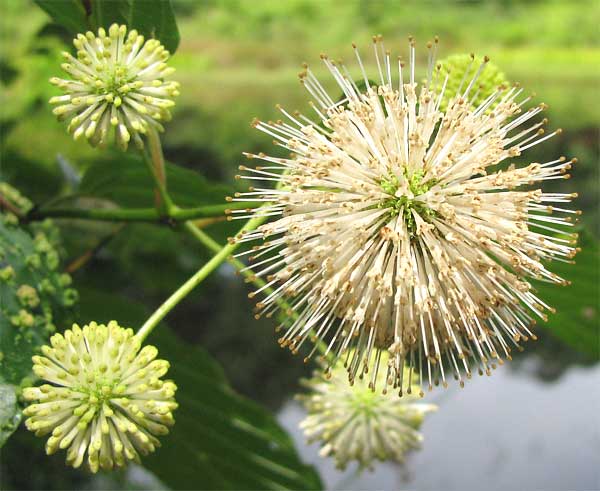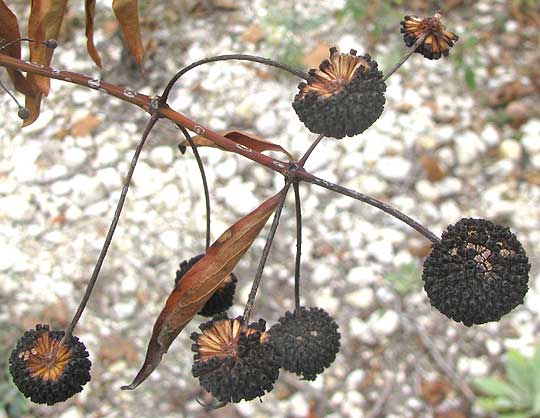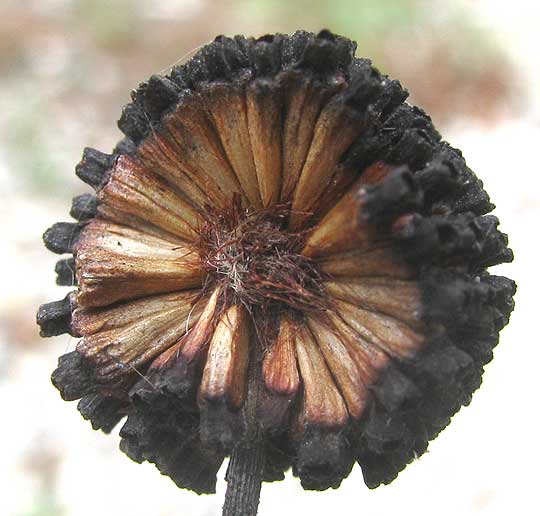Excerpts from Jim Conrad's
Naturalist Newsletter

from the the June 23, 2008 Newsletter, issued from the forest near Natchez, Mississippi; elevation ~400ft (120m), ~N31.47°, ~W91.29°:
BUTTONBUSHES BLOOMING
Also arising from the mud along Pipes Lake {~N31.38°, ~W91.16°, elev. ~140ft (~40m)}'s shore, as well as out into the water itself, were head-tall bushes producing flower clusters such as those shown above.
Those are Buttonbush flowers, Buttonbush being CEPHALANTHUS OCCIDENTALIS of the Coffee Family, the Rubiaceae. In fact, Buttonbush leaves have the same shape and general appearance of Coffee bushes. If you're in North America you probably know Buttonbushes because they're common in wetlands from southeastern Canada and California south to Honduras, sometimes forming nearly impenetrable thickets.
In the picture, each spherical item is a 1.3-inch wide cluster of many flowers. If you look closely at the white cluster you can see the individual flowers, which are white and very slender. Each tiny flower bears at its top four petal-like lobes (sometimes five), and four stamens (rarely five) protruding from the corollas. In the picture, the stamens are topped with very small, oval, brownish anthers, which open to release pollen. The stiff-looking, white, sticklike things below the anthers are the stamens' filaments.
Anatomically, most flowers are "superior," meaning that their sepals or calyx lobes, petals or corolla, and stamens all arise below the ovary. Flowers in the Coffee Family are "inferior," meaning that those flower parts arise above the ovary.
Once the flowers are pollinated they fall off, leaving the many closely packed ovaries forming small, green balls considerably smaller than the white balls in the picture. Eventually the spheroid of ovaries matures into a dark-reddish-brown cluster about 3/4-inch in diameter, the individual ovaries squeezed together so tightly that the cluster looks like just one brown fruit. However, as winter comes on and the balls dry out, they crumble into individual dry fruits.
Ducks eat these achenes and deer browse on Buttonbush's twigs and foliage, but, relative to the bush's abundance, not to any great extent.
from the December 2, 2012 Newsletter issued from the valley of the Dry Frio River in northern Uvalde County, southwestern Texas, on the southern border of the Edwards Plateau; elevation ~1750m (~5750 ft); N29.62°, W99.86°; USA
BUTTONBUSH FRUITING
Nowadays the Buttonbush's flowering heads are long past, but in their stead appear fruiting heads, as shown below:

In that picture you can see that the shrub's leaves, despite our not yet having had a hard frost, are withered and falling away. Also you can see that the balls are disintegrating, usually from the top down. Probably the top parts go first because birds visit the balls and the tops are easiest to pick at. The Morton Arboretum reports over two dozen bird species that are attracted to Buttonbush.
Buttonbush's balls are composed of many crammed-together, achene-type fruits set upon their ends. Achenes are dry, one-seeded fruits that don't split open upon maturity. Below you can see better how they fit together to form the ball:

Each achene is crowned by the hard, blackened calyx of the flower from which it arose. Since the calyx arises atop the fruit, not below it as is usually the case, it's apparent that the flowers forming the fruits had what botanists call inferior ovaries. Flowers with superior ovaries produce their calyx, corolla and sexual parts below their ovaries. The Buttonbush's inferior ovaries are to be expected since it's a member of the mostly tropical Coffee Family, the Rubiaceae, for which one of the main field marks is inferior ovaries.
When I first arrived here and saw that the local Buttonbushes' leaves were consistently narrower than those I'm familiar with back East, I thought we might have a different species here. However, it's the same species as in the East. Maybe the arid climate causes the narrower leaves. A second buttonbush species, the Mexican Buttonbush, does extend into the US from Mexico at the southernmost tip of Texas well south of here.